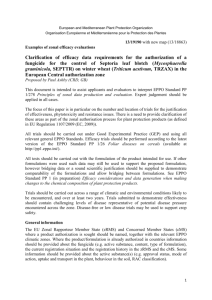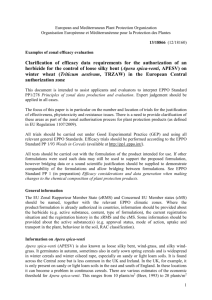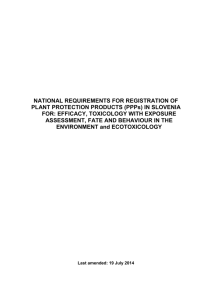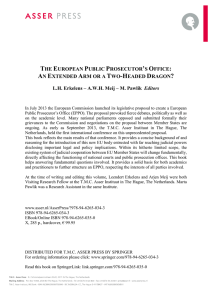Yellow rust - European and Mediterranean Plant Protection
advertisement
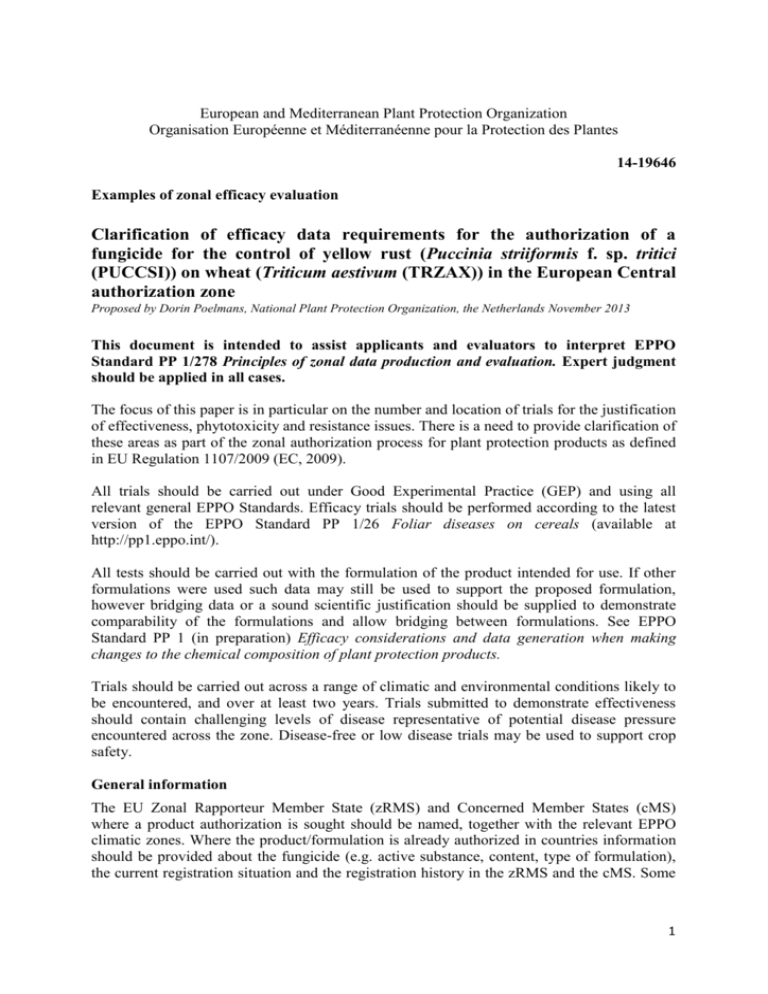
European and Mediterranean Plant Protection Organization Organisation Européenne et Méditerranéenne pour la Protection des Plantes 14-19646 Examples of zonal efficacy evaluation Clarification of efficacy data requirements for the authorization of a fungicide for the control of yellow rust (Puccinia striiformis f. sp. tritici (PUCCSI)) on wheat (Triticum aestivum (TRZAX)) in the European Central authorization zone Proposed by Dorin Poelmans, National Plant Protection Organization, the Netherlands November 2013 This document is intended to assist applicants and evaluators to interpret EPPO Standard PP 1/278 Principles of zonal data production and evaluation. Expert judgment should be applied in all cases. The focus of this paper is in particular on the number and location of trials for the justification of effectiveness, phytotoxicity and resistance issues. There is a need to provide clarification of these areas as part of the zonal authorization process for plant protection products as defined in EU Regulation 1107/2009 (EC, 2009). All trials should be carried out under Good Experimental Practice (GEP) and using all relevant general EPPO Standards. Efficacy trials should be performed according to the latest version of the EPPO Standard PP 1/26 Foliar diseases on cereals (available at http://pp1.eppo.int/). All tests should be carried out with the formulation of the product intended for use. If other formulations were used such data may still be used to support the proposed formulation, however bridging data or a sound scientific justification should be supplied to demonstrate comparability of the formulations and allow bridging between formulations. See EPPO Standard PP 1 (in preparation) Efficacy considerations and data generation when making changes to the chemical composition of plant protection products. Trials should be carried out across a range of climatic and environmental conditions likely to be encountered, and over at least two years. Trials submitted to demonstrate effectiveness should contain challenging levels of disease representative of potential disease pressure encountered across the zone. Disease-free or low disease trials may be used to support crop safety. General information The EU Zonal Rapporteur Member State (zRMS) and Concerned Member States (cMS) where a product authorization is sought should be named, together with the relevant EPPO climatic zones. Where the product/formulation is already authorized in countries information should be provided about the fungicide (e.g. active substance, content, type of formulation), the current registration situation and the registration history in the zRMS and the cMS. Some 1 information should be provided about the active substance(s) (e.g. approval status, mode of action, uptake and transport in the plant, FRAC classification). Information on the disease Yellow rust (Puccinia striiformis f. sp. tritici) is a wheat disease occurring throughout Europe. P. striiformis is mainly distributed in areas with cool temperatures, especially in mountainous and upland areas. P. striiformis occurs on wheat crops in the cooler areas in which wheat is cultivated. It can cause severe infections in maritime climates such as Western Europe, and right across Europe to the Middle East. Yellow rust can occur on all aerial parts of the plant, but is most frequently seen on the leaves. The pathogen spreads by means of airborne urediospores. When spores land on wheat plants they germinate in high humidity, usually at temperatures of less than 15°C, and the germ tubes enter the leaves or other parts of the plant via the stomata. Once inside the leaf, haustoria are inserted into the mesophyll cells and the mycelium spreads along the leaf. In mature leaves it spreads longitudinally between the veins of the leaf. Lines of bright yellow new urediospores are produced and give the typical striped appearance on the leaves. The pustules are often arranged into conspicuous stripes and their linear orientation between vascular bundles can progress the length of the leaf blade. Damage is caused to the plant by extraction of nutrients via the haustoria of the pathogen and by disruption of the epidermis, which reduces the water retention capacity of the leaves. The major grain-producing parts of the wheat plant are the flag leaf and the ear, and severe infections on these parts of the plant may cause large reductions in yield. Greater reductions occurred with earlier infections, yields of susceptible cultivars could be reduced by 50% or more under severe and prolonged infection in the field. The major method of control is the use of resistant cultivars. The development of systemic fungicides has led to the use of chemical control, particularly in areas where yields are high, as in Western Europe, where the cost of fungicide application is low in comparison with the value of the crop. Epidemics of yellow rust require appropriate weather conditions and the presence of susceptible cultivars. Information on wheat production in the Central Zone Wheat production occurs in the whole Central authorization zone of the European Union. The main countries for wheat production in the Central authorization zone are: France (Maritime regions), Germany, UK and Poland. Further information on wheat production is available from the Eurostat website1 and also the Belgium paper on EPPO zonal webpage2. However, the applicant should always make sure to use reliable and the most updated source of information. Intended Use(s) The applicant should clearly describe the details of the recommended use for each country where registration is sought. (See EPPO Standard PP 1/240, Harmonized basic information for databases on plant protection products particularly points 15 - 34). 1 2 http://epp.eurostat.ec.europa.eu/portal/page/portal/agriculture/data/main_tables http://www.eppo.int/PPPRODUCTS/zonal_efficacy/zonal_efficacy.htm 2 Number and distribution of trials required for an authorization Effectiveness ((6.2) Commission Regulation 284/2013), (OECD KIIIA1 6.1.3) To support an authorization in the Central zone, which encompasses different EPPO climatic zones, more than the EPPO recommended number of trials results (6-15) for a single EPPO zone will be needed. The European Central authorization zone, encloses three different EPPO zones of comparable climates: the Maritime zone (Ireland, the United Kingdom, the Netherlands, Belgium, Luxembourg, Germany, the Czech Republic and Austria), the North-East zone (Poland) and the South-East zone (Slovenia, Slovakia, Hungary and Romania). The climatic variation across the Central authorization zone, particularly with respect to temperature and rainfall during the main period of crop growth is high. This variability largely explains the differences in severity of yellow rust across the zone. This may have impact on the product performance and response. However, the greatest impact of the climate variability is expected to be on development and subsequent severity of the disease. Regions with drier spring/early summer climates (e.g. south eastern EPPO countries) typically have less severe and shorter epidemics. In these countries the GAP (in terms of the dose and the number of applications) may differ from that required in the more disease prone wetter Maritime countries. Trials should cover the typical variation in climatic conditions. Where data suggest lower required doses in some areas, it may be necessary to conduct further trials to support the proposed doses. When planning the number and distribution of trials required for an authorization in the Central zone, the majority number of trials (10-14 fully supportive trials) should be carried out on the location where yellow rust is most severe, typically in the central/western regions of the maritime EPPO zone (indicated with red dots in Figure 1). Note that it is also possible to perform some trials in the North of France, where this disease can also be important, and Denmark because of their comparable climate (maritime climatic EPPO zone), although these countries do not belong to the Central authorization zone (Figure 1). It is important in these trials that disease developed to challenging levels in the untreated plots. To cover the whole range of climatic variation, another 6-10 fully supportive trials should be performed in the other climatic EPPO regions, although conditions are less challenging here. Diseases levels in such areas would not be expected to be as severe, but it is important to encompass a range of disease pressures. Possible locations of these trials are indicated in blue in Figure 1. Also some trials located in countries of the North East and South East EPPO climatic zone which do not belong to the Central authorization zone, but with comparable climate may be relevant (see Figure 1, e.g. LT and BG). For more information on the use of the extra-zonal data see PP 1/278. Data should be presented separately for high disease pressure of the Maritime region and for low diseases pressure of the North- and South-East regions to enable a consideration of whether there is any impact of climatic conditions on performance. Quantitative yield data should be presented as specified in EPPO Standard PP 1/26. 3 Figure 1. Visualization of the planning of trials for yellow rust in wheat (in red are those in the maritime EPPO zone). Note that this is a schematic overview of the distribution and do not show exact locations (e.g. instead of a trial in Germany, a trial in the UK or North of France is also possible). The EPPO climatic zones: please note that the borders are intentionally broad indicating that there is an area of gradual change in climate between the zones proposed (as defined in EPPO Standard PP 1/241 Guidance on comparable climates). Minimum Effective Dose (6.2) (OECD KIIIA1 6.1.2) Data generated across a range of disease pressures (as described above) is important in determining whether a single dose rate is appropriate for the whole zone, or whether the claim should differentiate depending on disease pressure. The claimed dose(s) should be justified by including at least one dose below the recommended one in some trials (see EPPO Standard PP 1/225 Minimum effective dose for more information). Some justification of the proposed dose for high disease pressure of the Maritime region and for low diseases pressure of the Northand South-East regions should also be provided because the performance of the product may be influenced by climatic conditions. In addition consideration should also be given to the number of applications needed across the different EPPO climate regions. Resistance (6.3) (OECD KIIIA1 6.2.8) The variability in sensitivity data should be established from sites in which no previous usage of this active substance has occurred following the principle outlined in EPPO Standard PP 1/213 Resistance risk analysis. Isolates should be taken from a range of the main wheat growing areas within the Central zone. The pathogen risk should be estimated also in regard to the local intensity of disease development that is based on weather conditions, fertilization, 4 irrigation, cultural practices and degree of resistance of cultivars. According to the FRAC yellow rust belongs to the group of plant pathogens with low risk of development of resistance to fungicides or of minor commercial importance. Decisions on the sensitivity data should be made on a case by case basis. Phytotoxicity to target plants (including different cultivars), or to target plant products (6.4.1) (OECD KIIIA1 6.2.1, 6.2.5, KIIIA-6.1.4.1-3) Observations for phytotoxic effects should be made in all effectiveness trials. Trials should be conducted with a range of varieties. Specific crop safety trials are only required if phytotoxicity is observed in the effectiveness trials. In such cases, yield data are necessary. Phytotoxicity can vary depending on climatic conditions and varietal tolerance. Therefore, it is necessary to have phytotoxicity data from all the different EPPO climatic zones of the authorization zone. For more information about phytotoxicity assessment see EPPO Standard 1/135 Phytotoxicity assessment. In preparation of the biological dossier, the applicant should consider whether there is a need for data on possible effects of the test product on transformation processes, which could occur with involvement of e.g. yeast. For fungicides some intrinsic activity against yeasts may be expected hence specific tests on brewing and baking are likely to be required. For more information see EPPO Standard 1/243 Effects of plant protection products on transformation processes. Impact on treated plants or plant products to be used for propagation (6.4.5) (OECD KIIIA1 6.2.5) EPPO Standard PP 1/135 Phytotoxicity assessment provides an indication of the circumstances under which data on plant parts for propagation are required. Impact on other plants, including adjacent crops (6.5.2) (OECD KIIIA1 6.2.7) The decision frameworks in EPPO Standards PP 1/207 Effects on succeeding crops and PP 1/256 Effects on adjacent crops should be followed when addressing these points. Effects on beneficial and other non-target organisms (6.5.3) (OECD KIIIA1 6.2.4) When there are claims for use as part of an Integrated Pest Management Strategy, special trials may be required on a national basis for fungicides in cereals. Relevant data produced for the Ecotoxicology section 9.5 or existing IOBC classifications for the active substance may be used. Extrapolation to other crops This example may be used for other cereal hosts. Puccinia striiformis (PUCCST) is major disease on wheat, but is also reported to infect triticale (Triticosecale sp. TTLSS, TTLSO & TTLWI), durum wheat (Triticum durum, TRZDU), rye (Secale cereale, SECCE) and barley (Hordeum vulgare (HORVX). Where effectiveness in wheat has been adequately demonstrated and where the other above mentioned crops are minor it may be possible to extrapolate similar claims of activity, although a limited number of trials to demonstrate crop safety are likely to be required. These should be conducted in the main production areas. Further advice on the requirements for these other cereal crops should be sought from countries in which use is intended as in some cases claims may not be allowed if the disease is of such low importance that control is not justified. See also PP 1/257 Efficacy and crop safety extrapolations for minor uses. 5 References Regulation (EC) No 1107/2009 of the European Parliament and of the Council of 21 October 2009 concerning the placing of plant protection products on the market and repealing Council Directive 79/117/EEC and 91/414/EEC. Official Journal of the European Union L 309, 1-50. Commission Regulation (EU) No 284/2013 of 1 March 2013 setting out the data requirements for plant protection products, in accordance with Regulation (EC) No 1107/2009 of the European Parliament and of the Council concerning the placing of plant protection products on the market http://eur-lex.europa.eu/LexUriServ/LexUriServ.do?uri=OJ:L:2013:093:0085:0152:EN:PDF OECD Guidance Documents for Pesticide Registration http://www.oecd.org/env/ehs/pesticides-biocides/oecdguidancedocumentsforpesticideregistration.htm Crop Protection Compendium http://www.cabi.org/cpc/ 6

